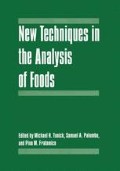Abstract
The microscope, in its various forms, is a most appropriate technique for evaluating food structure. Various researchers have helped elucidate the location and distribution of cereal components which in turn related to their functionality in baked goods such as bread (1,2,3,4). Laser Scanning Confocal Microscopy (LSCM) is unlike other light microscopy techniques (e.g. fluoresence, bright field and polarized light) in which non-coherent light is applied and all the reflective light is collected, including that above and below the focal plane, resulting in a blurred or diffused image for a specimen with considerable thickness (5). The confocal microscope uses a point light source (laser) which is focused on a small volume within the specimen rendering an image of in-focus plane only, with the out-of-focus parts appearing as black background (4). Additionally, the confocal microscope provides an opportunity to observe a 3-D image without the need to physically section the sample, allowing a disturbance-free observation of the specimen. Although Transmission Electron Microscopy (TEM) can provide a 3-Dimensional view of the specimen, the sample must be dried or frozen (or replicated with platinum and carbon) since TEM is carried out in vacuum. Confocal microscopy can be used to observe dynamic process such as dough formation (5) since no such restriction on sample preparation is necessary. Finally, two powerful techniques such LSCM and fluoresence microscopy can be combined to localize and identify different components by using specific fluorescent labels (such as fluorescein for protein, Texas Red for starch, and Nile Blue for lipids).
Access this chapter
Tax calculation will be finalised at checkout
Purchases are for personal use only
Preview
Unable to display preview. Download preview PDF.
References
R.E. Angold. 1979. Cereals and bakery products, In: “Food Microscopy,” J.G. Vaughan ed., Academic Press, New York, pp 121–138.
G.E. Moss. 1976. “Examination and Analysis of Starch and Starch Products”, Applied Science Publishers, London.
R.G. Fulcher and P.J. Wood. 1983. Identification of cereal carbohydrates by fluoresence microscopy, In: “New Frontiers in Food Microstructure,” D.B. Bechtel ed., American Association of Cereal Chemists, St. Paul, MN, pp. 11–147.
E. Varriano-Marston. 1983. Polarization microscopy: applications in cereal science, In: “New Frontiers in Food Microstructure,” D.B.Bechtel, ed., American Association of Cereal chemists, St. Paul, MN, pp. 71–105.
H.S. Cavanagh, W.M. Petroli and J.V. Jester. 1995. Confocal microscopy: uses in measurement of cellular sturcture and function. Progress in Retinal and Eye Research. 14 (2): 527.
G.J. Brakenhoff, H.T.M. Van der Voort, E.A. Van Spronsen and N. Nanninga. 1988. Three-dimensional imaging of biological structures by high resolution confocal scanning laser microscopy. Scanning Microscopy. 2 (2): 33.
I. Heertje, P. van der Vlist, J.C.G. Blonk, H.A.C.M. Hendrickx and G.J. Brakenhoff. 1987. Confocal Scanning Laser Microscopy in food reserach: some observations. Food Microstructure. 6: 115.
J.C.G. Blonk, and H. van Aalst. 1993. Confocal scanning light microscopy in food research. Food Research International. 26: 297.
Y. Vodovotz, E. Vittadini, J. Coupland, P. Chinachoti and D.J. McClements. 1996. Bridging the gap: the use of confocal microscopy in food research. Food Technology. 50 (6): 74.
W.A. Jensen. 1962. Botanical Histochemistry Principles and Practice. D.M. Whitaker, R. Emerson, D. Kennedy and G.W. Beadle (eds.) W.H. Freeman and Comp., San Francisco.
Y. Vodovotz and P. Chinachoti. 1999. Visualization of white bread with a confocal microscope. American Laboratory. In press.
D.R. Sandison and W.W. Webb. 1994. Background rejection and signal-to-noise optimization in confocal and alternative fluorescence microscopes. Applied Optics. 33: 603.
N. Krog, S.K. Olesen., H. Temaes and T. Joensson. 1989. Retrogradation of the starch fraction in wheat bread. Cereal Foods World 34 (3): 281.
P. A. Rao, A. Nussinovitch and P. Chinachoti. 1992. Effects of selected surfactants on amylopectin recrystallization and on recoverability of bread crumb during storage. Cereal Chemistry. 69 (6): 613.
Y. Vodovotz. 1996. Aging of Starch and bread as Studied by DSC, DMA, NMR and Confocal Microscopy. Doctoral dissertation, University of Massachusetts, Food Science.
Author information
Authors and Affiliations
Editor information
Editors and Affiliations
Rights and permissions
Copyright information
© 1998 Springer Science+Business Media New York
About this chapter
Cite this chapter
Vodovotz, Y., Chinachoti, P. (1998). Confocal Microscopy of Bread. In: Tunick, M.H., Palumbo, S.A., Fratamico, P.M. (eds) New Techniques in the Analysis of Foods. Springer, Boston, MA. https://doi.org/10.1007/978-1-4757-5995-2_2
Download citation
DOI: https://doi.org/10.1007/978-1-4757-5995-2_2
Publisher Name: Springer, Boston, MA
Print ISBN: 978-1-4419-3307-2
Online ISBN: 978-1-4757-5995-2
eBook Packages: Springer Book Archive

